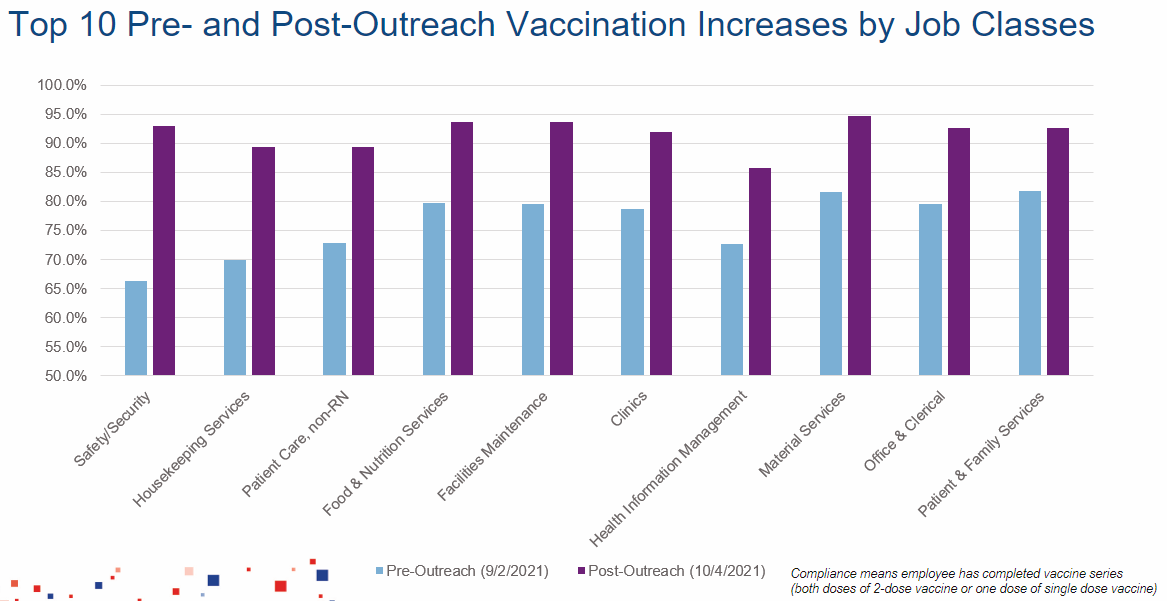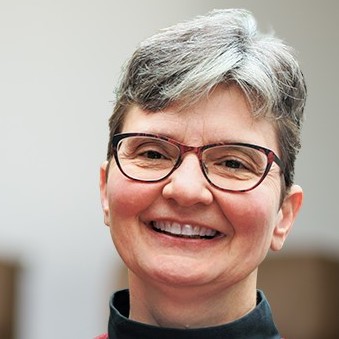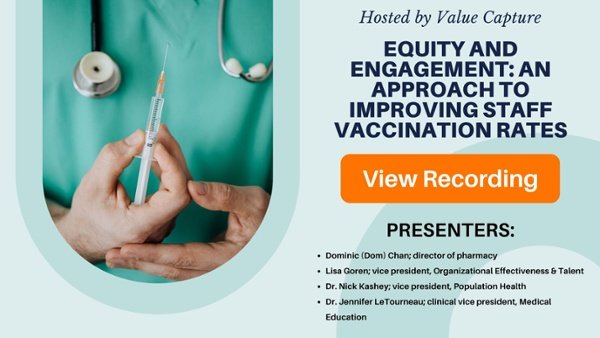A team from Legacy Health System presented a webinar hosted by Value Capture, "Equity and Engagement: An Approach to Improving Staff Vaccination Rates," on December 7, 2021. The Legacy Health presenters were:
- Dominic Chan, director of pharmacy
- Lisa Goren, vice president, Organizational Effectiveness & Talent
- Dr. Nick Kashey, vice president, Population Health
- Dr. Jennifer LeTourneau, clinical vice president, medical education
This post presents some highlights and excerpts from the webinar. You can click below to register to view the webinar.
Focus on Health Equity, Access and Understanding
Lisa Goren began by describing the context and purpose of the work the panelists and more than 60 other Legacy Health professionals undertook.
"We're going to talk about the need for justice and equity in the COVID 19 campaigns within all of healthcare. And I should say that even though we're talking about vaccination efforts today, what we're really talking about is change in human behavior. So everything that we're talking about is really cross-applicable."
Lisa noted that the webinar panelists would also discuss the tactics for engaging racially diverse employees, and identifying stakeholders and developing messaging to build vaccine confidence.
As the delta variant accelerated, leading to internal and state government vaccine mandates to be put in place in August 2021, Legacy's staff vaccination rate was nearly 85%. Facing an ambitious timeline, Legacy rejected a hard-line approach of saying to staff, essentially, there's a mandate and you have until September 30 to comply, or you will be suspended. Instead, Legacy had "a different take, and that was that a requirement or a mandate isn't enough to change behavior."
Lisa explained, "We had a hunch that there were people who didn't know about the mandate because of a lack of access to certain communication channels, both at home and at work. We also believed that there were people who, for good reason, didn't feel safe to get a vaccine. And there are probably people who actually don't know how to access the vaccine. There were people who believed they didn't need to get the vaccine because they'd already had COVID."
"So the goals of our work were to ensure that employees had access to the educational material from a trusted source and in a convenient location. We wanted to make sure people had the information they needed in order to make the decision that was best for them."
Lisa also said that a goal was to remove the complexity from the ever-changing information and make it easy to understand and non-clinical. Also, importantly, a goal was to make it clear that getting the vaccine was a condition of continuing employment. "Clarity is kindness."
"Our target audience primarily were employees who were members of populations disproportionately impacted by COVID. We know that COVID disproportionately impacted certain communities of color, the Hispanic community and the Black community primarily, but there are a lot of racially diverse people who have been disproportionately impacted by this pandemic."
Setting Aside the "Perfection" Mindset of Healthcare, and Multi-Modality Tactics
Dominic Chan then began presenting, starting with how the team tackled the very short timeline to close as much as possible the 16% gap of unvaccinated employees. "In the face of the challenges we faced, we as a group, at our first meeting... realized that we don't have enough time. We don't have enough people. We don't have enough resources, but we are going to do that best that we can."
"The approach of not letting the fear or the drive for perfection in the face of something that would impact the livelihoods of the people around us, we needed to set aside that Type A healthcare approach to do problem solutioning and solving."
Dom noted that over the course of the two months until the deadline, Legacy staff vaccination rate increased to 96% (from nearly 85%), with rates of "90% or higher across all individuals who identified their races or ethnicities."
"We came to the impasse of looking at the challenges of misinformation, social status, and medical racism, the traditional modalities of communicating and educating within the healthcare industry are twofold. One, an email. Two, a sheet of paper in the bathroom in front of you as you sit on the toilet. Those have been the most common approaches. And we said, that's not enough when someone's job is at stake."
"So we [applied] multiple approaches to it. I'll highlight four."
"One is to combat the misinformation at a virtual and pandemic-driven virtual webcast level. We did 20 town halls reaching across different hospital sites, reaching into individual interdepartmental individuals, identifying the types of questions and personas that made up the workforce of them. But when you're talking to a group of clinic physicians, that's very different than talking to the facilities and maintenance group. Their needs or wants, their North Star of decision making, is very different. So we had to change our message, it wasn't a one-size-fits-all with the town halls."
"We also took the modality or tactic of going to the people... a push method of information, knowing that there are very few departments within organizations that have a vast majority of their employees privileged enough to stop what they're doing, pick up their phone without being disciplined for it, and to listen in on a virtual town hall."
"We also set up an outreach hotline, where we connected individuals, confidentially, to either an administrator who could walk them through the human resources or employment logistics, or connect them very rapidly to a one-on-one confidential conversation with a clinician."
"Lastly, we maintained a weekly communication of safety education, taking the messages that came out of the town halls, the huddles, the hotlines, and pushing it out to the people in the form of FAQs, as well as a single myth-buster in which we took head-on a lot of misinformation that was arising during our forums and/or that we're seeing popularized through social media.
"Cutting across it from an ethnicity standpoint, we had our greatest increases in those who identified as American Indian, Black, Latino / Latinx, with an increase of up to 18.5%, constantly greater than 10%. Many of these individuals would not have had the opportunity to have an informed decision just by virtue of the medical racism that occurs, that is innately built into organizational communication."
Dom then shared rate increases by departments:

"I have no doubt in my mind that if we just cookie-cutter in a one-size-fits-all our message and approach and collaboration and the stakeholders that we engaged, the numbers would not look like this. The differences wouldn't look like this. And I think that a lot of it came down to just listening, listening, listening, listening, listening, and taking people along with us to make sure that the messenger that was giving the information was a trusted individual rather than in electronic form or an anonymous voice in a box."
Approaching People as Individuals with a Mindset of Providing Information, Rather Than "Convincing" Them
When asked why the Legacy team decided to approach the vaccination gap from an equity lens, Dr. Nick Kashey said, "Our biggest concern as an organization was that we would approach that deadline and suddenly have laid off a number of employees of color, who we didn't do our due diligence to make sure they had all the information and availability of information to make their decision for themselves, and to make an informed, educated decision about their vaccination status."
"And if we got to that deadline and wound up laying off people because they didn't have the information they needed, we didn't do enough of our legwork to answer their questions. That would be the perpetuation of systemic racism that we've been committed as an organization to becoming an anti-racist organization and stopping the perpetuation of these institutional forms of racism. That was our North Star, our guiding principle behind the whole effort."
Dr. Jennifer LeTourneau responded to the question of how the team handled the ongoing challenge of addressing misinformation. She said, "This was so hard, as a clinician watching the media, the headlines, hearing people talk about misinformation. As Nick alluded to, we had regular meetings about what was out there. We all brought our ideas about what were the things that we had seen, how we might address those issues."
"Then through the town halls, this iterative process, we learned more things. There were times when we were doing town halls where people would ask questions, but none of us really knew what the answer was."
"So we had to be very vulnerable as clinicians and say, 'I don't know, let me get back to you.' And we always had a follow-up process. One thing we were very conscientious of doing is ensuring that we didn't dismiss the misinformation. We understand that all this information out there, it's hard to sort out what's real... We're here to help you wade through all that information... We weren't trying to convince you to get vaccinated. We were trying to help you have the best information possible to make the best choice for you."
Responding to a question later in the webinar, Dom recommended not trying to "convince" people. "The key message I remember taking back to our group was this - our goal isn't to convince anyone. The instant that we do that, the instant an organization's intent is to convince someone to do something that they don't want to do, we've lost the argument. We've lost."
"Instead, our goals should be being able to understand the other person a little bit more and for them to understand us a little bit more, so that we are amicable about getting back together and continuing the conversation on a later date."
Dom also shared two other recommendations for anyone else undertaking a similar challenge.
"Don't be paralyzed by the idea of perfection. Instead, go into it knowing [that you're going to trip over yourselves]. Which leads to the next piece of advice, don't do it alone. Because as we tripped over each other, we picked each other up."
There is so much more discussion on the challenges, insights and advice from the Legacy Health panelists in our webinar recording. Whether you are trying to implement a vaccine mandate or solve another critical issue, the lessons of Legacy Health can apply to help you resolve the issue and improve performance. Complete the short form to access this webinar recording, and be sure to check out or other webinars, and other learning events.

Written by Melissa Moore
Ms. Moore’s responsibilities center on marketing and communications. Prior to joining Value Capture, she served as a Marketing Manager at Reed Smith, a global law firm. Other career steps include: co-founding and operating a trend-setting coffeehouse; securities lawyer; and, service and equipment sales.


Submit a comment